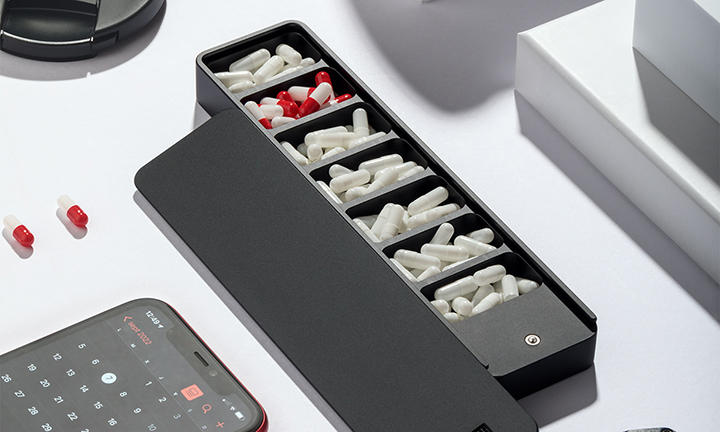Tavish Rice ’20 Built a Better Pill Case
‘Ikigai is a great example of starting the design process with understanding a need’
When he was in sixth grade, the middle school Tavish Rice ’20 attended in Miami hosted a mini-Olympics. Students were encouraged to invite their parents. “That’s the first time my Dad couldn’t come to one of my games,” says Rice, “He was too sick.”
Earlier that year, Rice’s father, Doug, was diagnosed with chronic inflammatory demyelinating polyneuropathy (CIDP), a rare autoimmune condition. CIDP affects the nervous system; the patient’s immune system has a bug that makes it think its nerve endings are the enemy and starts to attack itself. The symptoms often begin with tingling and numbness, cramps, loss of reflexes and balance, and progress to chronic nerve pain. Within the first six months, Doug’s condition forced him to use a walker. “He went from being this rugby player, athlete, superstar dad, all the way down to unable to move a single part of his body.” says Rice.
Doug underwent chemotherapy. The goal was to break down his immune system so that it would reboot itself without the bug. When Doug took a turn for the worse, he entered the ICU and was read his last rights by a priest. “I work to turn those memories into positive ones,” says Rice.
But the chemo worked, and Doug began a slow recovery over several years. Since he finished treatment, Doug has to take pills five times a day.
By the time Rice arrived at Princeton, he’d become interested in entrepreneurship. While kicking for the football team, he majored in economics and earned a certificate in entrepreneurship. After graduating in 2020, Rice took a job at a real-estate investment firm in Washington, D.C., but he couldn’t stop thinking about building something of his own.
When his father started taking medication, he tried using dozens of cases to organize his pills. The only cases on the market were plastic and broke easily. None of the cases Doug tried had individual lids for each compartment, each used a single lid design, which, when opened, exposed all seven compartments. Doug’s condition limited the mobility of his hands. “He couldn’t use his hands to pick pills up out of the case,” says Rice. His father needed a case he could turn over to dump out one compartment of pills at a time.
Rice wanted to build a pill case out of metal with a sliding lid that exposed one compartment at a time. He turned to YouTube for tutorials on building a product, designs, and manufacturing. After several months and many rounds of drawings, he found an engineer who helped create his first design, the Mission case: an aluminum case with three compartments and a sliding lid. Rice ordered the first 100 cases from the engineer, and they arrived in November 2021.
Rice named the brand Ikigai Cases. Ikigai is Japanese for “reason for being.” “Ikigai was something I learned about when we came up with the idea,” he says. “For me, having this mission of making something more out of my dad’s disease was a really strong why.”
Within three weeks, he sold 50 cases. In January 2022, he quit his job in real estate to focus on building the company full-time.
That May, Ikigai received more than 300 pre-orders. Rice promised the orders would be fulfilled by the first week of June. His girlfriend Aabi helped, and Rice’s younger brother Breton flew out to D.C. “He came up thinking he would be helping me out for a weekend,” says Rice. “He stayed the whole month.” Breton moved to D.C. to work on Ikigai full-time. They are now selling thousands of cases a month.
The cases have greatly shifted their father’s mindset around taking medication. “When you pull out a plastic pill case in front of people, you feel old and embarrassed,” he says. “Taking your medicine makes you feel like a victim. Tavish’s cases feel like a pocket watch. It’s a cool accessory.”
“Ikigai is a great example of starting the design process with understanding a need,” says Rafe Steinhauer ’07, who taught Rice during his sophomore year in Creativity, Innovation and Design, a course in Princeton’s Keller Center for Entrepreneurship. “I’m sure he went through many design iterations, but it all came after identifying a need and why the product would matter to real humans.”
The Keller Center is part of the Engineering Department, but it’s not only a center for Entrepreneurship and Design; social impact is at the heart of its mission. “I love seeing the impact Ikigai is having.” says Rafe, “It speaks to why the Keller Center is doing what it’s doing.”













1 Response
Edna Lin Impalli ’88 p’23
2 Years AgoInspiring Story
This type of personal-experience-driven entrepreneurship is inspiring. Princeton is full of great young minds but not all take risks and follow their passions. His product is actually one I unfortunately need and so I made a purchase to support his efforts (got in orange and black as an homage to our alma mater) and wish him luck in his future endeavors.